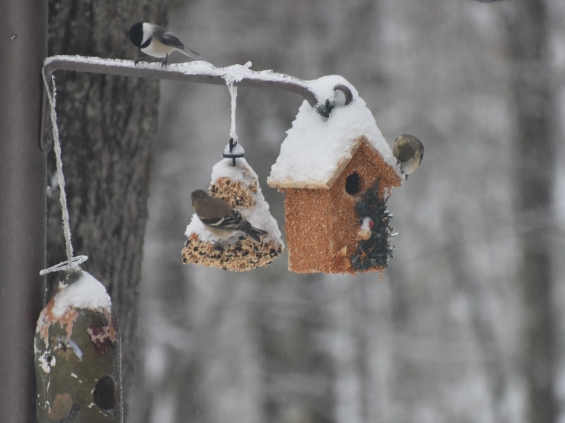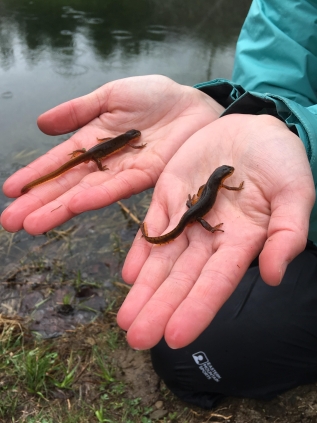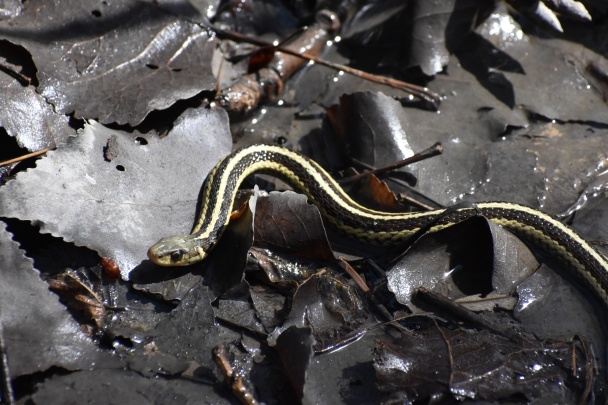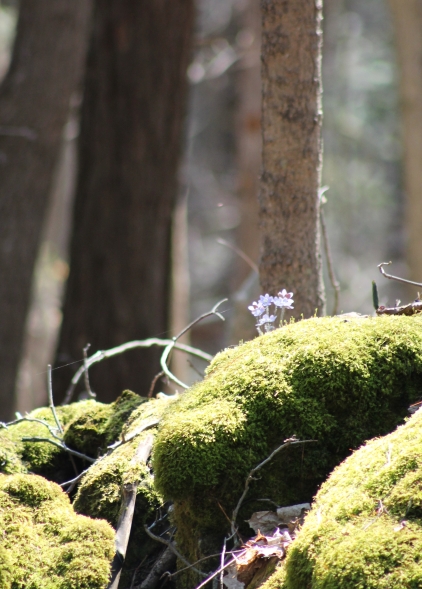Live in each season as it passes; breathe the air, drink the drink, taste the fruit, and resign yourself to the influence of the earth.
– Henry David Thoreau
Hey everyone! I know it’s been a while since my last post, but I have a lot of topics swimming in my head and sometimes it can be hard for me to pick one and research it thoroughly enough until I feel it’s ready to be published.
This post feels the most timely to me; if you live in the northeastern U.S., you’ve probably noticed how mild the winter has been. It’s only March, and yesterday it was 70 degrees in the southern part of my state. Needless to say, spring is quickly upon us! No matter where you live, spring brings life; birds, bugs, plants, and lots of babies of all species. So the purpose of this post is to give you some tips on how you can fix up your outdoor space to encourage wildlife to visit or take up residence.
But right off the bat, let’s get this out of the way – why should you fix up your yard for wildlife? The overall trend is that America (and most of the rest of the world) is becoming more urban, and public lands in America are becoming harder to find. An increase in private land most likely means more developed land, and thus less and/or more fragmented wildlife habitat. Your local wildlife needs all the help they can get in an increasingly urbanized world. If you’re bummed that your property is no longer part of a larger ecosystem home to owls and snakes and foxes – don’t fret! No matter what you do to the land you live on, you’re influencing the wildlife around you.
Wildlife is a large umbrella that includes reptiles, amphibians, mammals, bugs, and so forth. No matter what wildlife you’d like to have around, they all need the basics: food, water, and shelter. If you’d like to attract certain species or kinds of wildlife, you’ll need to dive deeper into their habitat requirements. I’m going to be as general as I can and I’ll aim towards telling you how to make the most diverse habitat. Oh, and obviously anything you’re able to do depends on the size of your property, the characteristics of your property, the surrounding properties, and where you live in the world – keep this all in mind as you read on.
Food:
All creatures need food, but that food depends on the species (you’ll get real sick of hearing me say that, huh?) and the time of year. Let’s start big: trees. There are evergreen trees (such as pines, junipers and hemlocks) that provide food for animals in the winter ranging from sap, to needles, and even their twigs. Evergreens are long lived, but often take longer to grow. Then there are hard- and soft-mast species. Hard-mast trees (such as oaks, beeches, and hickories) produce nuts and acorns that are rich in fat and important for animals when building fat reserves. Hard mast is only available in fall and winter. Soft-mast trees (such as plums, crabapples and dogwoods) produce fleshy fruits that are available in summer, fall and winter. Then of course there are shrubs that produce berries such as wild strawberries, wild raspberries, wild blueberries, and so on.
Before you start picking plants though, take a look around your land. What plants and trees do you already have? Have you observed wildlife utilizing any of them, whether that be for food or shelter? You also need to consider what soil you have – you may be able to assume this from the surrounding plants and trees, but it’s also easy enough to dig a soil pit. A soil pit will show you a profile of the types of soil under you, and from there you’ll know which plants will be most successful growing on your lot. But no matter what, make sure that whatever you plant is not invasive. Invasive plants will wreak havoc on your land, and could easily spread to surrounding areas. Planting native plants also often means they’re low maintenance, and may not need as vigorous watering as non-native flowers or trees. If you’re nervous about what is native to your area, fear not, Audubon has you covered! Audubon has a database where you can look up plants native to your area and will even tell you what type of bird prefers what type of plant. If you’re not interested in attracting birds (which…why the hell not), this is still a great jumping off point.

Two American Goldfinches (Spinus tristis) and a Black-capped Chickadee (Poecile atricapillus) taking turns at the birdfeeders.
You can have supplemental feedings on your land too, and the most popular (and probably least controversial) are birdfeeders. If you’d like a guide to different birdseed types, Cornell’s Lab of Ornithology have you covered here. Actually, other than birdfeeders the only thing you can really have is a squirrelfeeder (which if you’ve ever had a birdfeeder then you know it’s also a squirrelfeeder). Most state wildlife agencies discourage feeding wildlife; In New Hampshire (which is where I live), Fish and Game discourages feeding deer for a variety of reasons including increased risk to predation, the fact that they tend to travel more in winter if fed and deplete fat stores, and feeding a lot of animals in one location (no matter the species) could increase the spread of disease. On that note, let’s have the talk…
The birds and the bears.
Especially if you live in New England (although this is probably true for any state with black bears), you need to know that your birdfeeder will attract bears. It’s not a matter of if they’ll get into your birdfeeder, it’s when. In New Hampshire, Fish and Game recommends you don’t put your birdfeeder out until December 1st and remove them April 1st to avoid bear conflicts. The saying goes that “a fed bear is a dead bear”, and I can assure you that is true; People literally kill bears for getting into their bird feeders and it’s not illegal to do so in New Hampshire (see RSA 207:26-27)! That’s a larger topic for a later entry…But seriously, you need to understand that your birdfeeder will attract everything including predators to feast on the things eating from your birdfeeder. Don’t be upset when things other than birds take advantage of the food you’ve put out.
Water:
Water is a pretty easy one if you want it to be – you could simply put out a birdbath, either raised or on the ground (just make sure you clean them regularly). You could also build a small pond in your yard if you had the space and felt so inclined. Creating a backyard pond could be a great way to attract amphibians though, and who doesn’t want to have salamander neighbors? If you’d like more information on how to build a backyard pond, check out this guide by the National Wildlife Federation.

Two adult Eastern Newts (Notophthalmus viridescens)
Shelter:
Not only is shelter important for making animals feel safe in your space from predators, but it also offers a place for animals to breed, raise young, and possibly stick out tough weather. The kinds of shelter you could provide in your yard once again depends on the type of animals you’d like to have around (I told you I’d keep saying it). Generally speaking though, if you plant trees or shrubs in your yard for food sources, they could double as cover.
Because evergreen trees retain their needles year-round, they provide great over-wintering habitat for many animals. Deciduous trees, especially ones that are hard-mast species, are long-lived and often provide natural cavities that many animal species like to call home. And don’t immediately think that just because a tree is dead it’s no longer useful – many animals feed on and love to live in dead trees, also called snags. If you have a snag that doesn’t pose a property damage threat to your home, leave it up! As time passes, try pulling back the bark in the summer to look for salamanders, peak inside cavities (carefully of course) to see who’s inside, and see if you find any scratch marks that animals are making on the snag to stake your property as part of their own territory.

Common Garter Snake (Thamnophis sirtalis)
Oh, and leave your leaves! Not only do leaves on the ground provide great habitat for bugs, worms and amphibians, but leaves also act as a sponge and directs water to lower levels of soil, and act as a fertilizer for your soil as well. But the worms and bugs that live among the leaves are also a great food source for the other animals you’re trying to attract. Crazy right? It’s almost as if everything is tied together in some sort of system…
Other things to consider:
If you’d like to attract a diverse array of animals, you’ll need to create a diverse habitat. If you’re planning on planting new trees, shrubs or flowers, try to create layers; Big, tall trees, small, thin trees, shrubs, ferns, mosses…creating layers will allow for a greater array of animals to use your space year-round.
And be mindful of where you plant things. Try to keep vegetable beds and conventional plants closer to your house, and plant your more wild garden on the outskirts of your property to allow it to connect with the surrounding woods. Don’t just plop your food sources out in the open; put food sources near cover to allow animals to escape and feel safe as they forage. And if you’d like to plant evergreens, plant them on the north or north-west portion of your property to provide shelter from wind.
In my research for this post I discovered that New Hampshire has a small grant program for helping landowners restore or create wildlife habitat. Yes, you need at least 25 acres, but I’m sure this varies by state, so check out your local agencies’ grant programs if you need some financial help! If your state doesn’t offer anything like this but you’d still like your efforts recognized, the National Wildlife Federation offers a certification if you meet their requirements; you can pay a $20 certification fee (and portions of that help support local wildlife and go toward their education programs) and if you receive the certification you can put up a special “Certified Wildlife Habitat” sign, get a free one-year membership to their magazine, 10% off their merchandise, and more! If anything, it’s a cool way to acknowledge your efforts and further support wildlife conservation and preservation.

I’ll be using these tips this spring to spruce up (ehhh? See what I did there?) my yard, and in a future blog post I’ll show you my plan for my property sketched out and how we implement it. Oh and if you’ve noticed that this post doesn’t have as many hyperlinks to references as usual, it’s because a lot of these tips I learned from getting a degree in Wildlife Biology or from my work experiences. Below are other resources you can check out if you feel so inclined!
If you’ve made it this far, thanks so much for reading! And feel free to ask questions or show me what you’ve done to your yard through my ‘Get In Touch’ page.
So informative!! I will be using these tips for my own yard this spring for sure 🙂
LikeLike